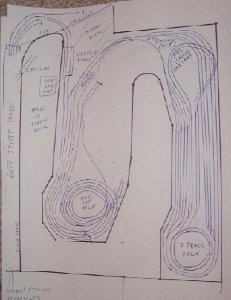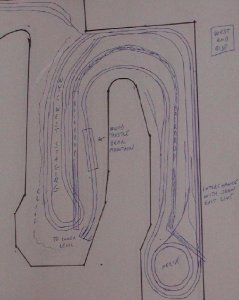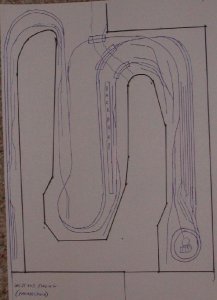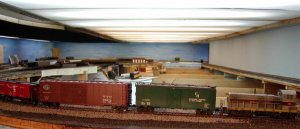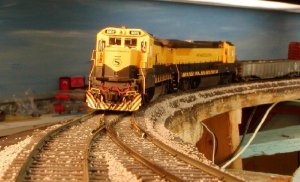OK, This will probably be kind of rambling. It will also be in installments because I will be doing most of it from work at lunch time. For those who enjoy reading for the sake of reading it may be entertaining. Others may not want to waste their time!
Drawings of the track plan have been roughly drawn over the last few lunch periods, and will be photographed and posted here in the next day or two. I do own Cadrail but am not willing at this time to devote the time required to learning it. In fact, I never drew actual scale plans even prior to construction of the layout. Frankly, they are not needed. I do prepare scale drawings of the layout area, then just place turnback curves of desired radius. The rest is done full size with track templates.
There are basically two questions which need to be answered prior to planning. Plan type (point to point, continuous, or something in between, like point to loop) and prototype/freelance. This assumes of course that more fundamental questions have been answered already, such as scale, era and geographical location.
Plan type: Experience building and operating layouts may well change your mind about what you originally thought you would want. I have to admit in the final analisis I never did decide, I chose both! I am more inclined to want to operate, but there is nothing that says a continuous type plan can't be operated protypically. And there are those occasions when I just want to see trains go by while I am doing something else. So all my plans have provided for continuous running. And the smallest of them still allowed way freight switching. One other thought here: Broadly speaking there are two benchwork styles, linear and "bowl of spaghetti", as I've seen it refered to in MRR. I have been a fan of linear plans for 30 years now, the main drawback being the lack of deep scenes. On the JGL, I have managed to eliminate that drawback, as I will talk about later. The main drawback of the sgetti schemes are the same train appearing in a scene more than once. This in itself wouldn't be so bad if done properly, but the image most often projected in magazine articles of the 60's when this type of plan was prevalent was one a train going one way on a lower level track, then coming back the other way a few inches higher and a few inches behind the first. Then often going back the first direction again still higher and further back still. This is what led to the idea of linear plans(that and the development of walkaround throttles!) I will talk a bit about prototype/freelance in my next post, I have to go now.
Gary
Drawings of the track plan have been roughly drawn over the last few lunch periods, and will be photographed and posted here in the next day or two. I do own Cadrail but am not willing at this time to devote the time required to learning it. In fact, I never drew actual scale plans even prior to construction of the layout. Frankly, they are not needed. I do prepare scale drawings of the layout area, then just place turnback curves of desired radius. The rest is done full size with track templates.
There are basically two questions which need to be answered prior to planning. Plan type (point to point, continuous, or something in between, like point to loop) and prototype/freelance. This assumes of course that more fundamental questions have been answered already, such as scale, era and geographical location.
Plan type: Experience building and operating layouts may well change your mind about what you originally thought you would want. I have to admit in the final analisis I never did decide, I chose both! I am more inclined to want to operate, but there is nothing that says a continuous type plan can't be operated protypically. And there are those occasions when I just want to see trains go by while I am doing something else. So all my plans have provided for continuous running. And the smallest of them still allowed way freight switching. One other thought here: Broadly speaking there are two benchwork styles, linear and "bowl of spaghetti", as I've seen it refered to in MRR. I have been a fan of linear plans for 30 years now, the main drawback being the lack of deep scenes. On the JGL, I have managed to eliminate that drawback, as I will talk about later. The main drawback of the sgetti schemes are the same train appearing in a scene more than once. This in itself wouldn't be so bad if done properly, but the image most often projected in magazine articles of the 60's when this type of plan was prevalent was one a train going one way on a lower level track, then coming back the other way a few inches higher and a few inches behind the first. Then often going back the first direction again still higher and further back still. This is what led to the idea of linear plans(that and the development of walkaround throttles!) I will talk a bit about prototype/freelance in my next post, I have to go now.
Gary


